Lifestyle
Inside L.A.'s oldest letterpress printer beloved by celebs, from Oprah to Jon Hamm

Surviving in an obsolete industry as long as Aardvark Letterpress has requires fundamental elements of entrepreneurship. Skill, dedication, creativity and professionalism are essential. General manager and co-owner Cary Ocon returns to another theme that’s kept what’s now the city’s oldest letterpress print shop running since 1968.
“Dumb luck,” he says.
Brothers Brooks and Cary Ocon on the floor of Aardvark Letterpress.

A test negative taped to the window of Aardvark’s office.
The lack of pretense and polish here belies the pedigree of much of Aardvark’s client base. Entertainment, fashion, art and other creative industries converge at the unlikely corner of 7th and Carondelet streets overlooking the southwest edge of MacArthur Park. Both basic and technically complex, making letterpress goods is a process that involves the physical act of pressing inked plates onto paper using mechanical presses in a manner that literally leaves a deeper impression.
A look through samples of artful work imprinted with boldfaced names and known entities from Apple to Rihanna’s Fenty Corp. to Valentino to Billie Eilish reveals the many layers of exceptionalism at work that inspire trusting partnerships. When actor and producer Jamie Lee Curtis established her production company Comet Pictures in 2019, “Aardvark Letterpress helped me start off with a strong logo and design,” she shares via text message. “I’m grateful for their expertise and guidance.”
In addition to relying on Aardvark to help shape their professional image and branding, people come here for a richly tactile experience. Personally printed matter made with this level of care has a way of inspiring connection and celebration.
“Cary and the team at Aardvark represent that sadly disappearing sector of tradecraft in the current culture,” actor Jon Hamm says via email. “Singularly, almost maniacally, devoted to one thing, they practice an attention to detail that is as precise and exacting as it is gorgeous in its finished quality.”
“We were typographers before we were printers,” Cary says, pointing to the hulking Intertype brand typography machine dating from the early 20th century that stands in one of the shop windows. With its complex movements that cast lead into a mold to form letters, leaving piles of shavings that get repurposed, it’s the original piece of equipment Cary’s father, Luis Ocon, obtained when he bought Aardvark Typographers 56 years ago in its previous location on Grand View Avenue.
The atmosphere is earnest and soulful, imbued with the makings of a one-act play setting and populated with a cast of characters. Gently sarcastic Cary handles overall management duties, while technically minded Brooks Ocon is the hands-on printing expert, alongside laser-focused master printer Bill Berkuta. Derek Pettet, a friend of Cary’s since the fourth grade, adds to the familiar dynamic.
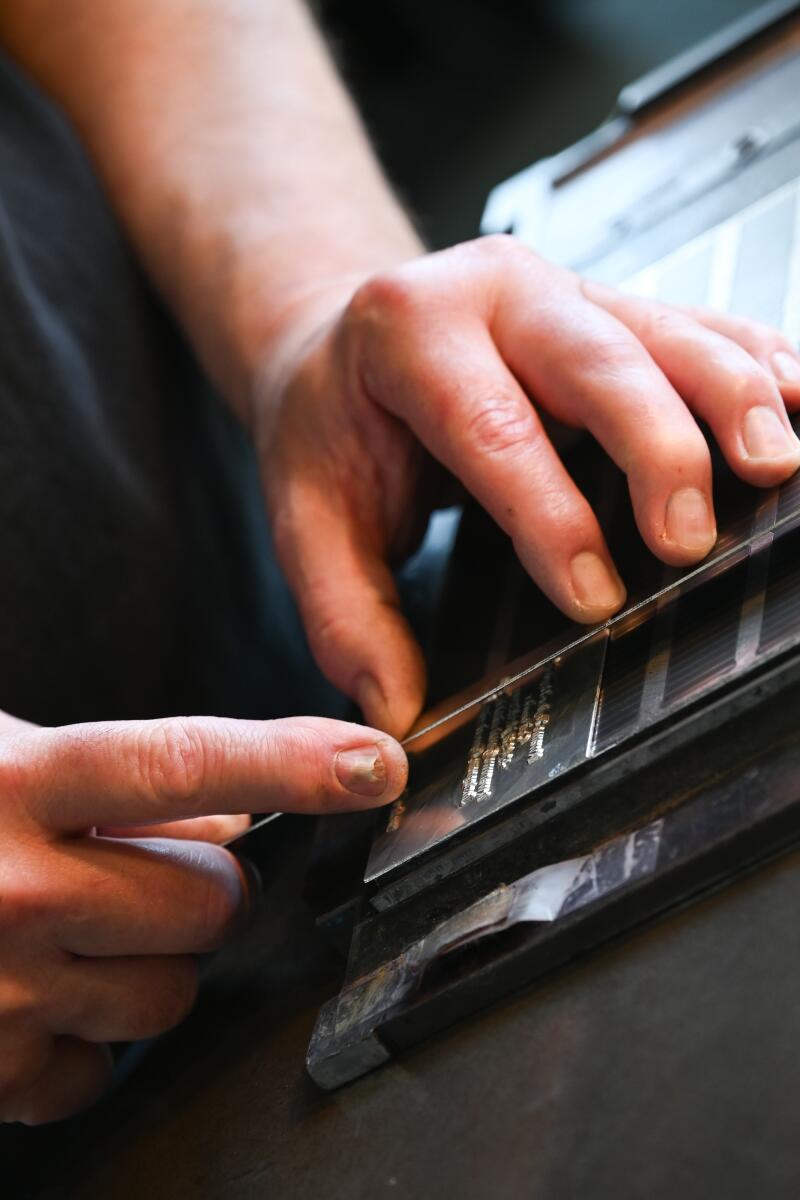
Brooks Ocon aligns a block for printing.
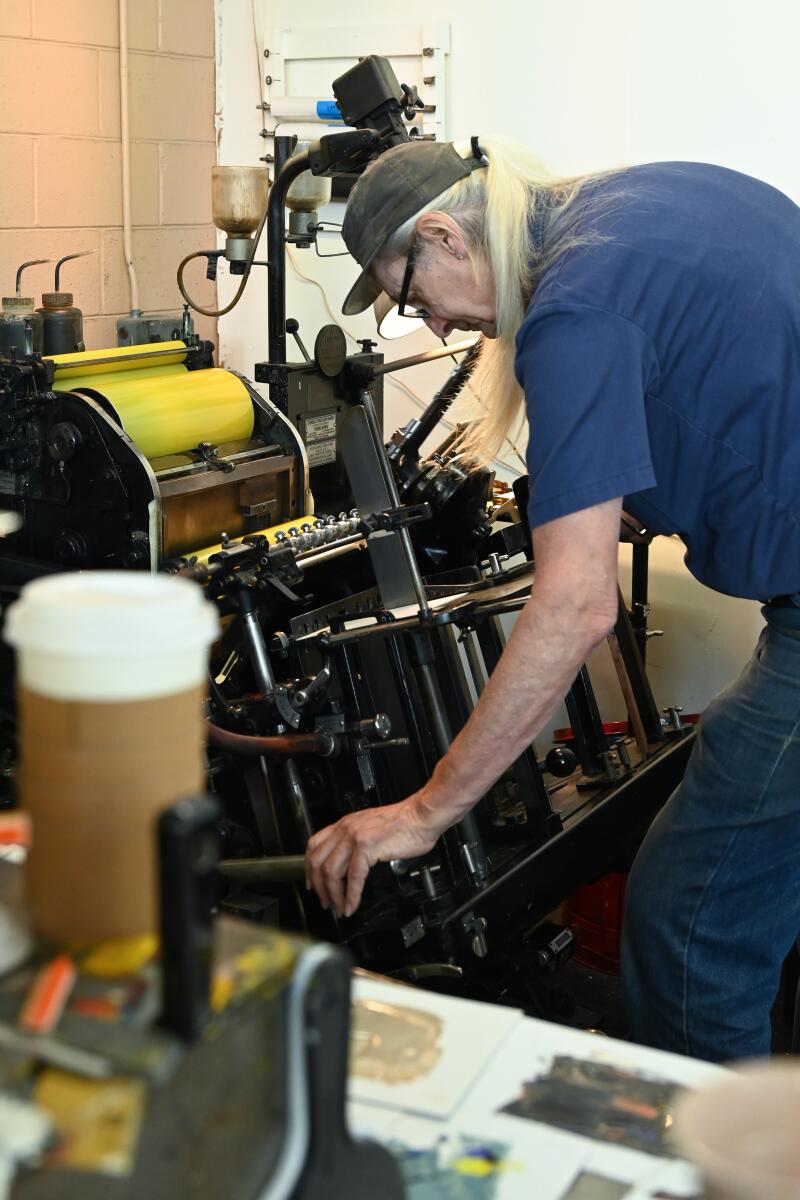
Master Printer Bill Berkuta prints an order for a customer.
Another moment of good timing came in 1988 when Brooks went to run an errand at H.G. Daniels art supply store on 6th Street. He couldn’t find what he was looking for, so he was directed to McManus & Morgan Fine Art Paper nearby. Brooks noticed a “for lease” sign in an adjacent storefront inside the detailed 1924 Spanish Colonial Revival-style Westlake Square Building designed by architect Everett H. Merrill. It struck him as an ideal place for Aardvark to put down new roots, and his father agreed.
“This was the original art district,” Cary notes, referencing the erstwhile concentration of art schools in the area. Otis Art Institute (later renamed Otis College of Art and Design), the ArtCenter School (ArtCenter College of Design) and Chouinard Art Institute, which was the predecessor of CalArts, were clustered within blocks of each other before relocating to their respective campuses. Multiple art supply stores catered to the student population.
The initial period of Aardvark Letterpress becoming a studio whose services are prized among glitterati clientele like Oprah Winfrey and art galleries and fashion houses, however, was not so smooth.
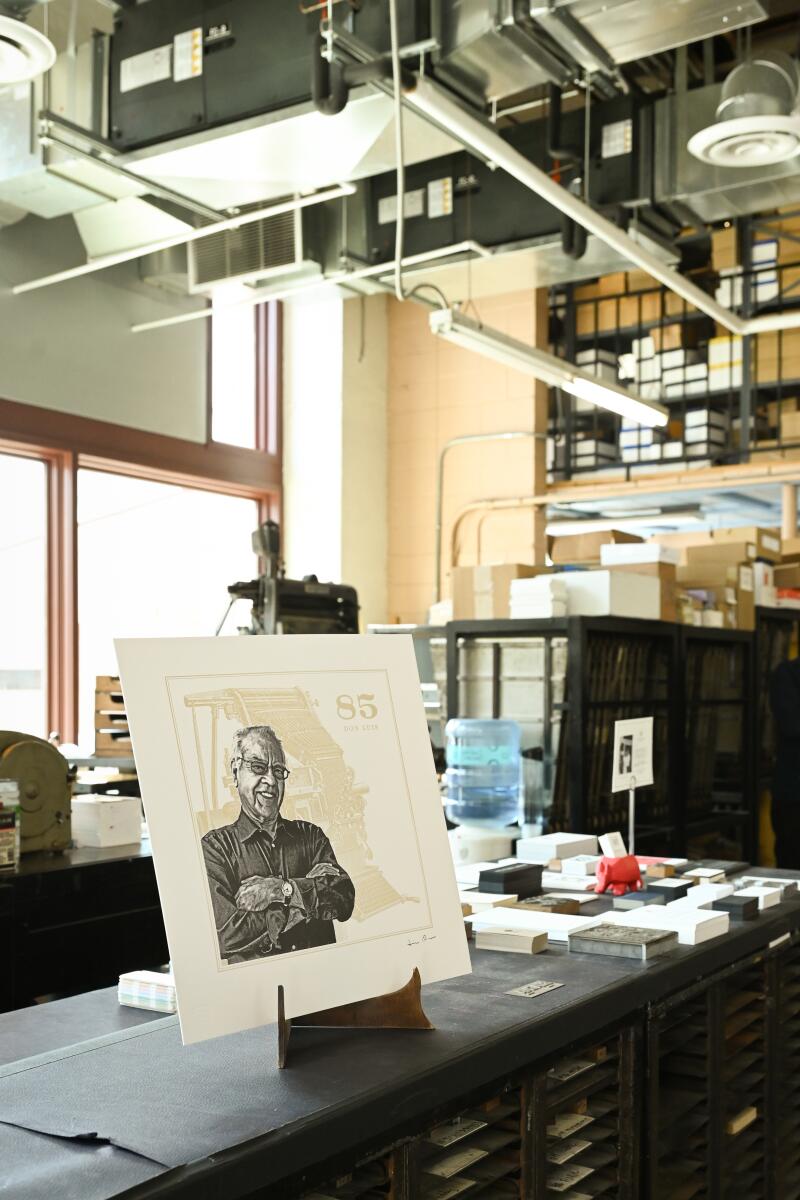
A print of founder Luis Ocon at Aardvark’s entrance.
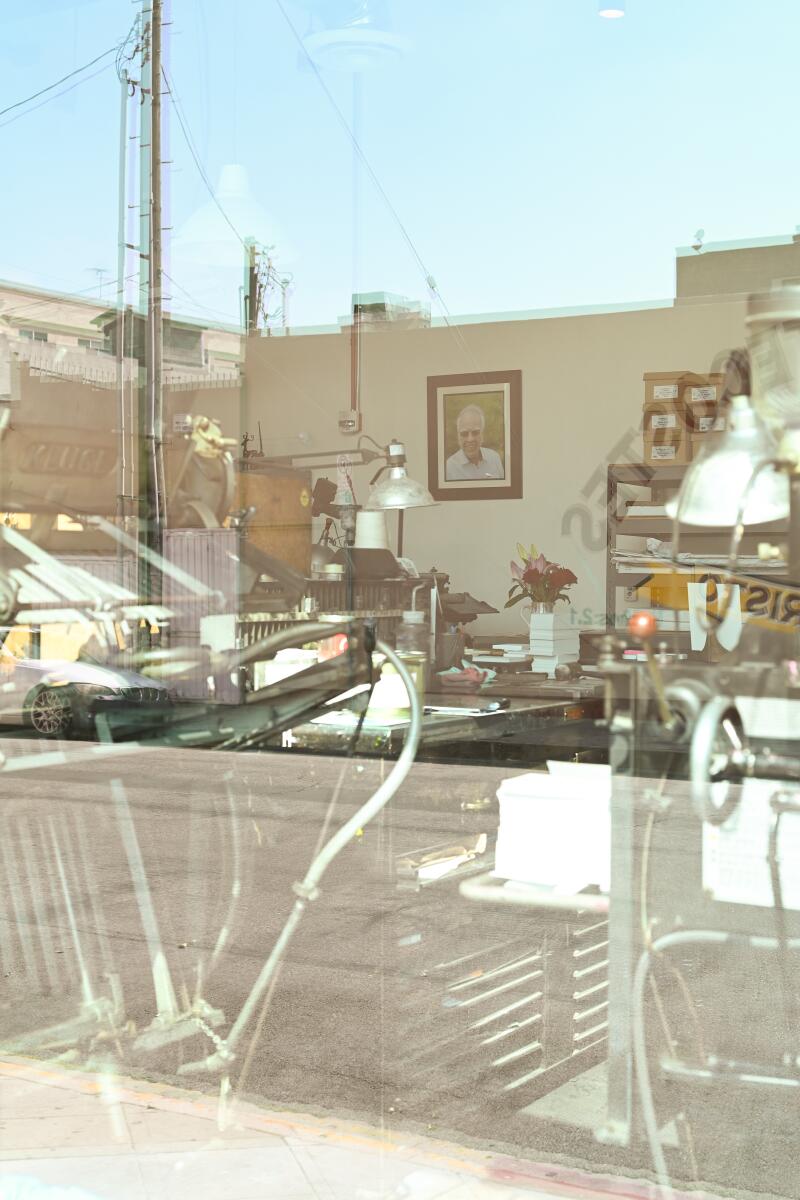
A view of Aardvark from South Carondelet Street.
A self-taught newspaper Linotype operator who immigrated to the U.S. from Mexico City, Luis Ocon’s purchase of Aardvark Typographers from his former boss Ken Matson coincided with the early adoption of computerized typesetting. “The business just started to nosedive because no one’s doing metal type anymore,” Cary explains. A customer suggested they learn to print in order to adapt to the changing times. “We got our first press and stumbled our way through letterpress printing,” Cary recalls.
While Cary was earning degrees at UC Berkeley and the University of Minnesota and then embarked on what would be an unsatisfying law career, Brooks and Luis were “struggling” to keep Aardvark afloat. Patriarch Luis, who passed away last year at the age of 86, was their stepfather who raised them as his own after meeting their mother, Helen, when Luis and Helen worked at the Holland House Cafeteria in what was Britts Department Store across the street from the Original Farmers Market. (The Ocon brothers also have two sisters and a half-sister.)
Decades before exclusive event planners trusted Aardvark Letterpress to create exquisite wedding invitations and noted artists such as Shepard Fairey partnered with the team on limited edition letterpress works, the business was hyper-local. Mariachi musicians would walk in on a Monday morning needing a fresh supply of business cards after a busy weekend promoting their talents.
Otis Art Institute in its original Westlake location accounted for the occasional job, and Gary Wolin, who still owns the century-old McManus & Morgan, referred customers who needed to print on the specialized papers he sold. The simpatico, closely connected businesses remain neighbors after Wolin downsized within the same building. (Newer tenants in the recently renovated property include taste-making firm Commune Design and Hannah Hoffman gallery.)
“We were a secret among graphic designers,” says Cary, who joined the business full time in 1998. Otis alumni would remember the old school print shop down the street, where the 1920s stencil-painted ceilings, multiple Heidelberg, Germany-made production presses, sturdy wooden drawers full of brass type in hundreds of fonts and other tools still serve as a portal to a pre-digital era.
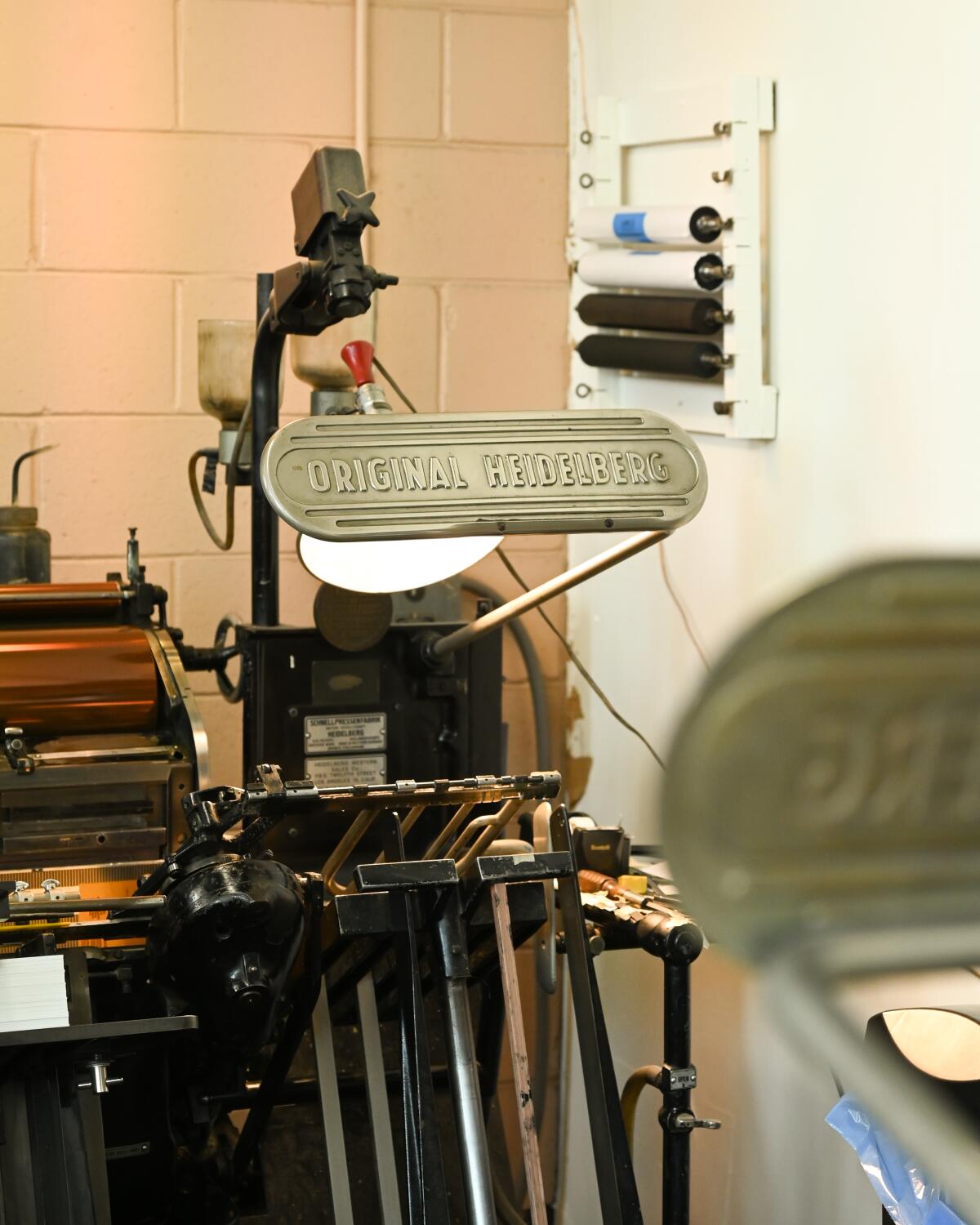
One of Aardvark’s six Heidelberg presses, vintage printing machines that apply designs directly to paper.
Because cultural tastes and trends have a way of being cyclical, toughing it out eventually paid off. Cary points to Martha Stewart’s championing of letterpress stationery as part of the reason why a revival came around in the early aughts. Aardvark was ready to meet new demand. “Again, it was dumb luck, because we had all the ability to set type.”
In this analog environment computers are used to manage workflow, and a processor upstairs transfers digital design files to make polymer plates used for most jobs. (Aardvark turns to A&G Engraving in Vernon to fabricate photoengraver metal plates for select projects and fine art prints.) This team’s expertise remains unrivaled in L.A. To mix inks, for instance, Berkuta refers to the color recipes on his well-worn Pantone fan deck and then relies on his eye and experience. “I’m weighing it in my head,” he says about getting the ratios right.
“I have collaborated with the team at the Aardvark studio adjusting plate pressure, ink colors and translucency to achieve sublime effects that no other medium can deliver,” artist Fairey states via email.
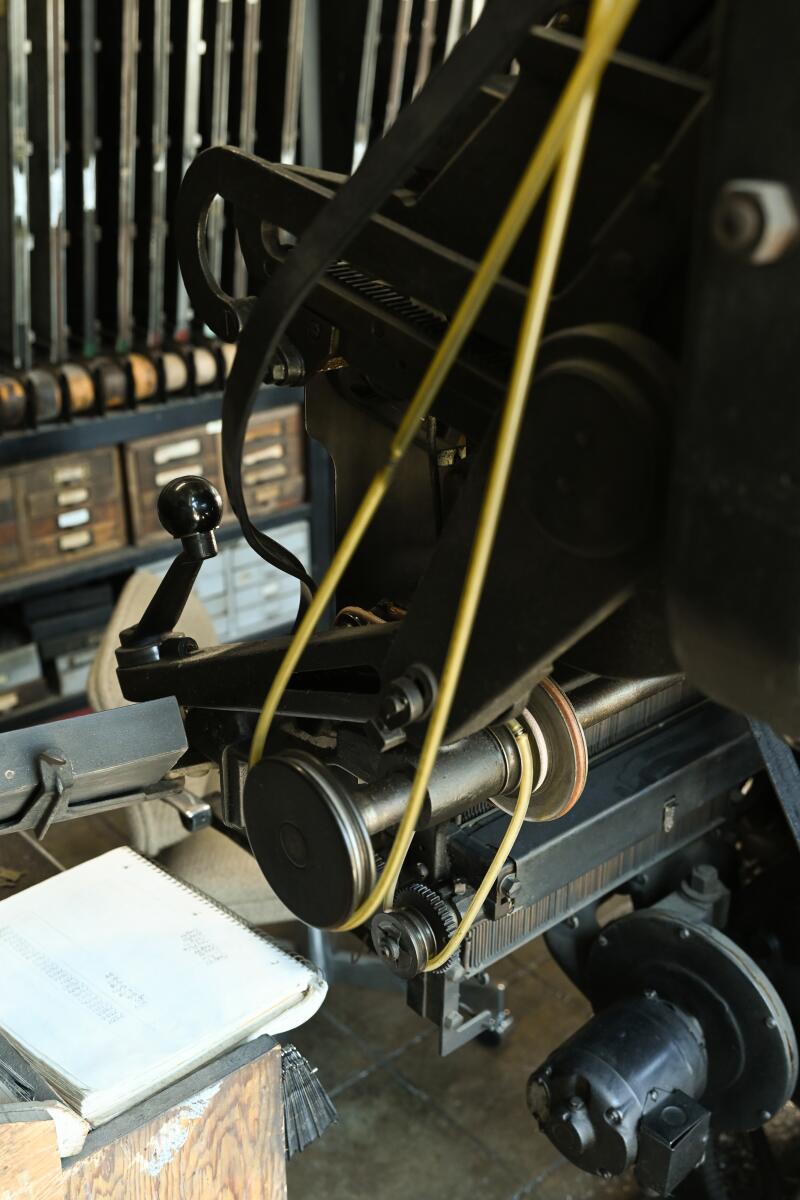
A linotype detail.
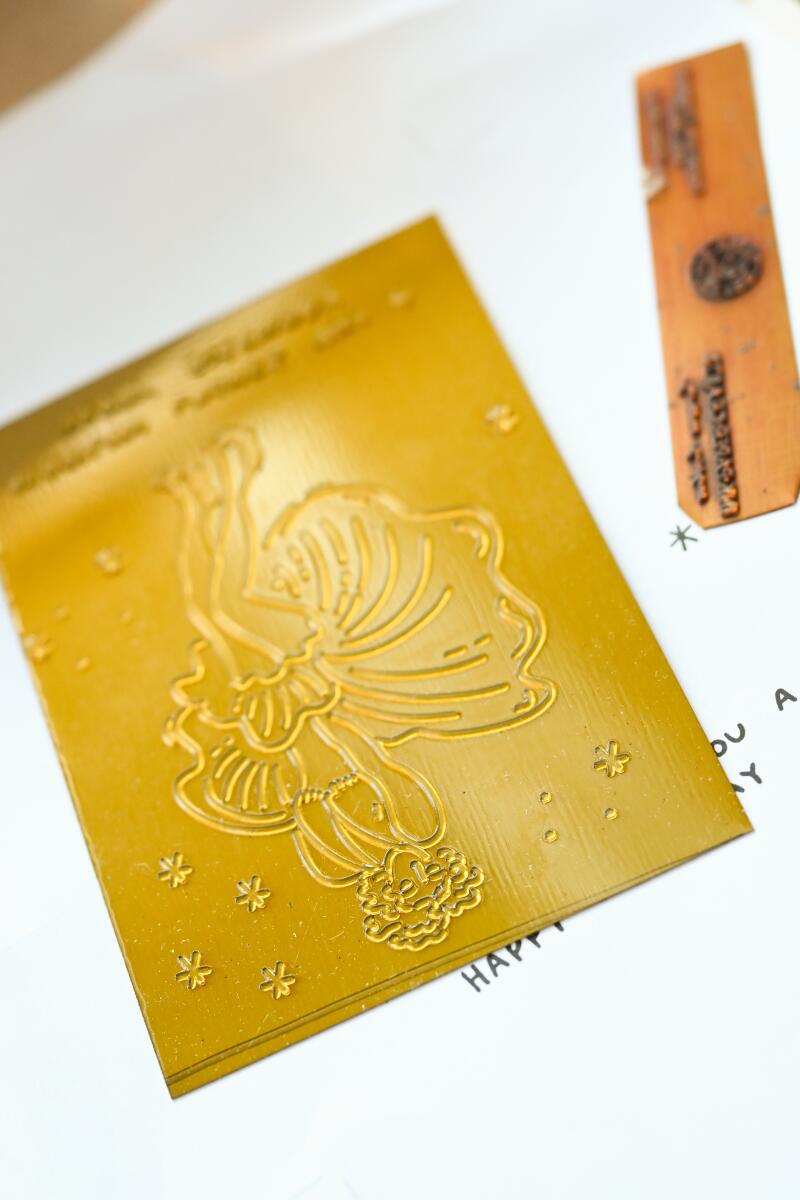
A Marilyn Monroe print on foil.
“I consider the invitations, menus and other objects they provided for our wedding to be works of art. Turns out 100 years of experience is worth something!” Hamm adds.
Despite the accolades, Cary is upfront about the challenges of sustaining this artisan enterprise. “To even print a simple business card, it’s much more labor intensive, so we can’t do it for 50 bucks,” he explains. To keep evolving, he’s preparing to launch Aardvark Printworks, a collection of letterpress art featuring imagery such as artists’ renderings of L.A. landmarks.
“I didn’t appreciate what we were doing,” Cary reflects about his earlier relationship to Aardvark Letterpress’ niche trade. “I see how it does move people.” Even if the family has yet to devise a clear succession plan for the future, the Ocons are proud of their legacy. “It’s something special. We’re thankful we can keep going,” Cary says.
Their impact reaches beyond Los Angeles. “I value a family business that keeps the craft of letterpress, an important printmaking tradition, alive and accessible to L.A. artists and businesses,” Fairey echoes.

Lifestyle
'Wait Wait' for July 27, 2024: With Not My Job guest Kathleen Hanna

Kathleen Hanna of The Julie Ruin performs onstage at the 2016 Panorama NYC Festival – Day 2 at Randall’s Island on July 23, 2016 in New York City. (Photo by Nicholas Hunt/Getty Images)
Nicholas Hunt/Getty Images/Getty Images North America
hide caption
toggle caption
Nicholas Hunt/Getty Images/Getty Images North America
This week’s show was recorded in Chicago with host Peter Sagal, judge and scorekeeper Bill Kurtis, Not My Job guest Kathleen Hanna and panelists Meredith Scardino, Peter Grosz, and Mo Rocca Click the audio link above to hear the whole show.
Who’s Bill This Time
Momala Takes Over; Assigned Seats Are Back; And The Heat Is On
The Olympic Torch Reporch
Our Summer Olympics Preview
Bluff The Listener
Our panelists tell three stories about someone committing an office faux pas, only one of which is true.
Not My Job: We quiz Bikini Kill’s Kathleen Hanna on Hanna-Barbera
Punk icon Kathleen Hanna plays our game called, “Kathleen Hanna Meet Hannah-Barbera.” Three questions about the animation studio.
Panel Questions
Hide Your Receipts; VR Meets ER; Avocado Apologies
Limericks
Bill Kurtis reads three news-related limericks: Situation Room Cocktails; Burrito Bird; Hopped Up Sharks
Lightning Fill In The Blank
All the news we couldn’t fit anywhere else
Predictions
Our panelists predict what will be the big story out of the Paris Olympic Games
Lifestyle
L.A. Affairs: At 77, I had a crush on my best friend’s widower. Did he feel the same way?
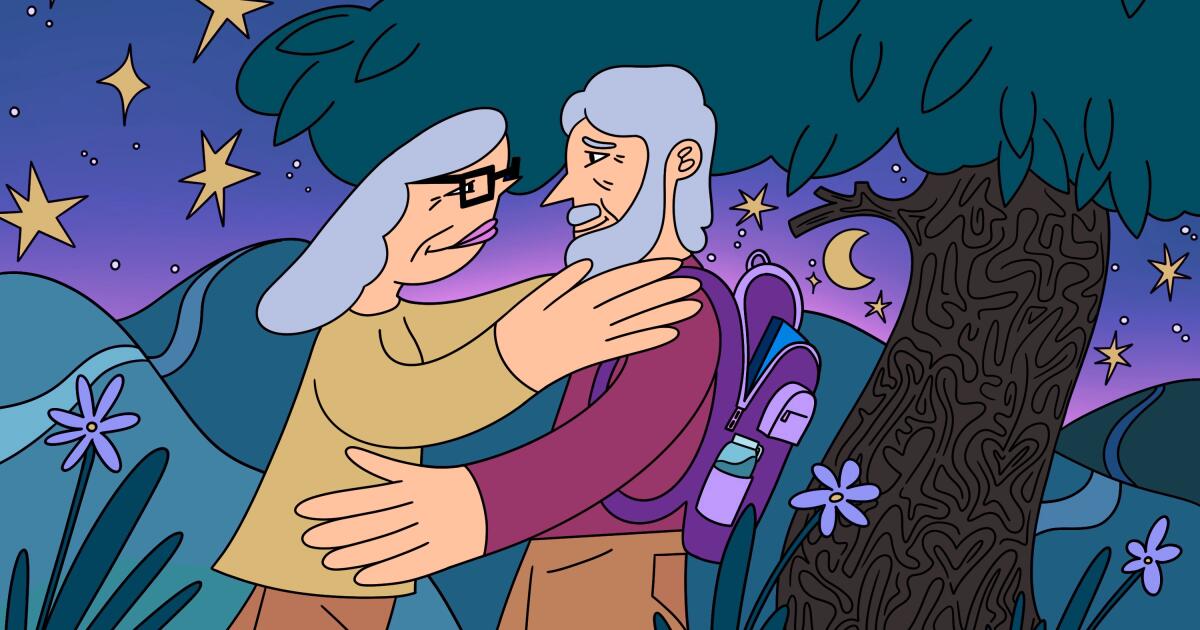
At 77, I had given up. After two failed marriages and years of unsuccessful dating, I accepted what seemed to be my fate: single for almost 40 years and single for however many remained. You don’t get it all, I told myself. I was grateful for family, friends and work. Life settled into what felt like order.
Until Ty.
As the husband of my best friend, he was no stranger, but he was usually peripheral. Then 10 years ago, my friend got lung cancer. I watched during visits, stunned at how nurturing Ty could be, taking care of her even though they had separated years before at her request.
After she died, Ty and I stayed in touch sporadically: a surprise sharing of his second granddaughter a year after we scattered my friend’s ashes, an invitation to the launch of my book a year later. Ty attended, hovering in the back, emerging after everyone left to attentively help load my car.
Two more years passed. During quiet moments, I remembered his sweetness. I also remembered his handsome face and long, tall body. Confused about what I wanted, I texted Ty, who’s an architect, under the guise of purchasing a tree for my backyard.
We spent an afternoon at the nursery, laughing, comparing options and agreeing on a final selection. When the tree arrived, I emailed a photo. He emailed a thank you.
Another three years passed, broken only by news of his third granddaughter and my memories of how good it felt to be with him. Alert to his attentiveness, but unsettled by both his remove and my growing interest, I risked reaching out again, this time about remodeling my garage.
Ty spent several hours at my house making measurements, checking the foundation and sharing pictures of his home in Topanga. His sketches for the garage arrived two weeks later via email.
I was grateful for his help but unsure over what sort of friendship we were developing, at least from his point of view. I, however, was clear. I wanted him to wrap his long arms around me, tell me sweet things and make me his.
Instead, I sent a gift card to a Topanga restaurant to thank him for his drawings.
“Maybe we should spend it together,” he texted.
We dined in the dusk of late summer. Our talk was easy. Discomfort lay in the unspoken. Anxious for clarity, I repeatedly let my hand linger near the candle flickering in the middle of our table. It remained untouched.
And that was as far as I was willing to go. I refused to be any more forward, having already compromised myself beyond my comfort level with what seemed, at least to me, embarrassingly transparent efforts to indicate my interest. Not making the first move was very important. If a man could not reach out, if he didn’t have the self-confidence to take the first step, he would not, I adamantly felt, be a good partner for me.
Two weeks later, Ty did email, suggesting an early evening hike in Tuna Canyon in Malibu. The setting was perfect. Sun sparkled off the ocean. A gentle breeze blew. We climbed uphill for sweeping coastal vistas and circled down to the shade of live oaks, touching only when he took my hand to steady me where the path was slippery. At the end of the trail, overlooking the juncture between the mountains and the sea, we stood opposite each other and talked animatedly for almost an hour, both of us reluctant to part.
Our conversation was engaging, but my inner dialogue was louder. When, I kept thinking, is this man going to suggest we continue the evening over dinner? We didn’t have to go out. We could eat at his house. It was 7 p.m., for God’s sake. Passing hikers even stopped to remark on our matching white hair and how well they thought we looked together. It was like a movie scene where the audience is yelling, “Kiss her, kiss her,” rooting for what they know is going to happen while the tension becomes almost unbearable. But bear it I did.
Each of us ate alone.
A few weeks later, at his suggestion, we were back at Tuna Canyon. This time Ty did invite me to end the evening at his house. Sitting close on his couch, but not too close, we drifted toward each other in the darkening room. His shoulder brushed mine reaching for his cup of coffee. My hip pressed his as I leaned in for my tea. Slowly, sharing wishes and hopes for our remaining years, we became shadows in the light of the moon. And in that darkness, in that illuminated space, he reached out.
This reticent man, this man who was so slow to move toward me, this sensitive man who hid himself behind layers so opaque I was unsure of his interest, released all that he had inside him.
“I wanted you,” Ty repeated again and again. “I was afraid of ruining things. You were her best friend. I didn’t want to lose your friendship.”
Our pent-up tension exploded.
Stunned and thrilled, I leaned into the space he opened.
Three years later, it is a space we continue to share: a place where neither of us has given up, a place where he wraps me in his long arms, a place we hold carefully against our diminishing days.
The author is the owner of a preschool in Venice as well as a psychotherapist, photographer and writer. Her first book, “Naked in the Woods: My Unexpected Years in a Hippie Commune,” was published in 2015. Her newest manuscript, “Bargains: A Coming of Aging Memoir Told in Tales,” is seeking a publisher. She lives in Mar Vista and can be found at margaretgrundstein.com, Instagram @margwla, Medium @margaretgrundstein and Substack @mgrundstein.
L.A. Affairs chronicles the search for romantic love in all its glorious expressions in the L.A. area, and we want to hear your true story. We pay $400 for a published essay. Email LAAffairs@latimes.com. You can find submission guidelines here. You can find past columns here.
Lifestyle
'Deadpool & Wolverine' is a self-cannibalizing slog
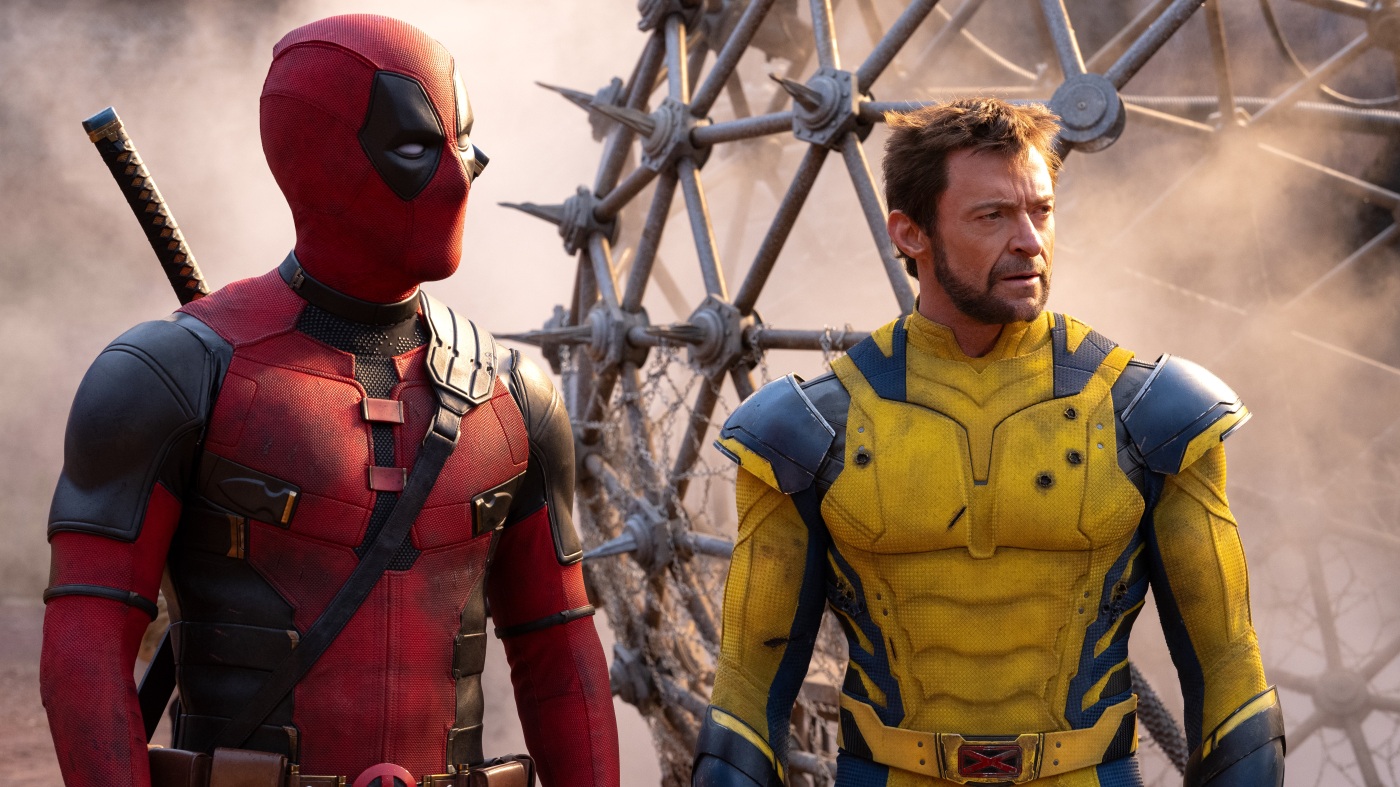
Ryan Reynolds stars as Deadpool and Hugh Jackman as Wolverine in an odd-couple action hero pairing.
Jay Maidment/20th Century Studios
hide caption
toggle caption
Jay Maidment/20th Century Studios
When Fox Studios released the first Deadpool movie back in 2016, it played like an irreverently funny antidote to our collective comic-book-movie fatigue. Wade Wilson, or Deadpool, was a foul-mouthed mercenary who obliterated his enemies and the fourth wall with the same gonzo energy.
Again and again, Deadpool turned to the camera and mocked the clichés of the superhero movie with such deadpan wit, you almost forgot you were watching a superhero movie. And Ryan Reynolds, Hollywood’s snarkiest leading man, might have been engineered in a lab to play this vulgar vigilante. I liked the movie well enough, though one was plenty; by the time Deadpool 2 rolled around in 2018, all that self-aware humor had started to seem awfully self-satisfied.
Now we have a third movie, Deadpool & Wolverine, which came about through some recent movie-industry machinations. When Disney bought Fox a few years ago, Deadpool, along with other mutant characters from the X-Men series, officially joined the franchise juggernaut known as the Marvel Cinematic Universe.
That puts the new movie in an almost interesting bind. It tries to poke fun at its tortured corporate parentage; one of the first things Deadpool says is “Marvel’s so stupid.” But now the movie also has to fit into the narrative parameters of the MCU. It tries to have it both ways: brand extension disguised as a satire of brand extension.

It’s also an odd-couple comedy, pairing Deadpool with the most famous of the X-Men: Logan, or Wolverine, the mutant with the unbreakable bones and the retractable metal claws, played as ever by a bulked-up Hugh Jackman.
The combo makes sense, and not just because both characters are Canadian. In earlier movies, Deadpool often made Wolverine the off-screen butt of his jokes. Both Deadpool and Wolverine are essentially immortal, their bodies capable of self-regenerating after being wounded. Both are tormented by past failures and are trying to redeem themselves. Onscreen, the two have a good, thorny chemistry, with Jackman’s brooding silences contrasting nicely with Reynolds’ mile-a-minute delivery.
I could tell you more about the story, but only at the risk of incurring the wrath of studio publicists who have asked critics not to discuss the plot or the movie’s many, many cameos. Let’s just say that the director Shawn Levy and his army of screenwriters bring the two leads together through various rifts in the multiverse. Yes, the multiverse, that ever-elastic comic-book conceit, with numerous Deadpools and Wolverines from various alternate realities popping up along the way.

I suppose it’s safe to mention that Matthew Macfadyen, lately of Succession, plays some kind of sinister multiverse bureaucrat, while Emma Corrin, of The Crown, plays a nasty villain in exile. It’s all thin, derivative stuff, and the script’s various wink-wink nods to other shows and movies, from Back to the Future to Furiosa to The Great British Bake Off, don’t make it feel much fresher. And Levy, who previously directed Reynolds in the sci-fi comedies Free Guy and The Adam Project, doesn’t have much feel for the splattery violence that is a staple of the Deadpool movies. There’s more tedium than excitement in the characters’ bone-crunching, crotch-stabbing killing sprees, complete with corn-syrupy geysers of blood.

For all its carnage, its strenuous meta-humor and an R-rated sensibility that tests the generally PG-13 confines of the MCU, Deadpool & Wolverine does strive for sincerity at times. Some of its cameos and plot turns are clearly designed to pay tribute to Fox’s X-Men films from the early 2000s.
As a longtime X-Men fan myself, I’m not entirely immune to the charms of this approach; there’s one casting choice, in particular, that made me smile, almost in spite of myself. It’s not enough to make the movie feel like less of a self-cannibalizing slog, though I suspect that many in the audience, who live for this kind of glib fan service, won’t mind. Say what you will about Marvel — I certainly have — but it isn’t nearly as stupid as Deadpool says it is.

-

 World1 week ago
World1 week agoOne dead after car crashes into restaurant in Paris
-

 Midwest1 week ago
Midwest1 week agoMichigan rep posts video response to Stephen Colbert's joke about his RNC speech: 'Touché'
-

 News1 week ago
News1 week agoVideo: Young Republicans on Why Their Party Isn’t Reaching Gen Z (And What They Can Do About It)
-

 Movie Reviews1 week ago
Movie Reviews1 week agoMovie Review: A new generation drives into the storm in rousing ‘Twisters’
-

 News1 week ago
News1 week agoIn Milwaukee, Black Voters Struggle to Find a Home With Either Party
-

 Politics1 week ago
Politics1 week agoFox News Politics: The Call is Coming from Inside the House
-

 News1 week ago
News1 week agoVideo: J.D. Vance Accepts Vice-Presidential Nomination
-

 World1 week ago
World1 week agoTrump to take RNC stage for first speech since assassination attempt
















